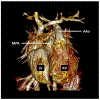Novel Techniques in Imaging Congenital Heart Disease: JACC Scientific Statement
- PMID: 38171712
- PMCID: PMC10947556
- DOI: 10.1016/j.jacc.2023.10.025
Novel Techniques in Imaging Congenital Heart Disease: JACC Scientific Statement
Abstract
Recent years have witnessed exponential growth in cardiac imaging technologies, allowing better visualization of complex cardiac anatomy and improved assessment of physiology. These advances have become increasingly important as more complex surgical and catheter-based procedures are evolving to address the needs of a growing congenital heart disease population. This state-of-the-art review presents advances in echocardiography, cardiac magnetic resonance, cardiac computed tomography, invasive angiography, 3-dimensional modeling, and digital twin technology. The paper also highlights the integration of artificial intelligence with imaging technology. While some techniques are in their infancy and need further refinement, others have found their way into clinical workflow at well-resourced centers. Studies to evaluate the clinical value and cost-effectiveness of these techniques are needed. For techniques that enhance the value of care for congenital heart disease patients, resources will need to be allocated for education and training to promote widespread implementation.
Keywords: angiography; artificial intelligence; cardiac computed tomography; cardiac magnetic resonance; digital twin technology; echocardiography.
Copyright © 2024 American College of Cardiology Foundation. Published by Elsevier Inc. All rights reserved.
Conflict of interest statement
Funding Support and Author Disclosures Dr Armstrong is a consultant for Edwards Lifesciences, Medtronic, Cook Medical, Abbott, and Starlight Cardiovascular; and receives research support from Siemens Healthineers and Renata Medical. Dr Grosse-Wortmann is a consultant for Siemens Healthineers. Dr Powell is a consultant for Siemens Healthineers. All other authors have reported that they have no relationships relevant to the contents of this paper to disclose.
Figures












References
-
- Simpson J, Lopez L, Acar P, et al. Three-dimensional echocardiography in congenital heart disease: an expert consensus document from the European Association of Cardiovascular Imaging and the American Society of Echocardiography. J Am Soc Echocardiogr 2017;30(1):1–27. - PubMed
-
- Shah SS, A D, Madan N, et al. Initial experience with Pediatric 3D Transesophageal Echo Probe and Imaging System. Abstract presented at: 8th World Congress of Pediatric Cardiology and Cardiac Surgery; August 27–September 1, 2023; Washington, DC.

